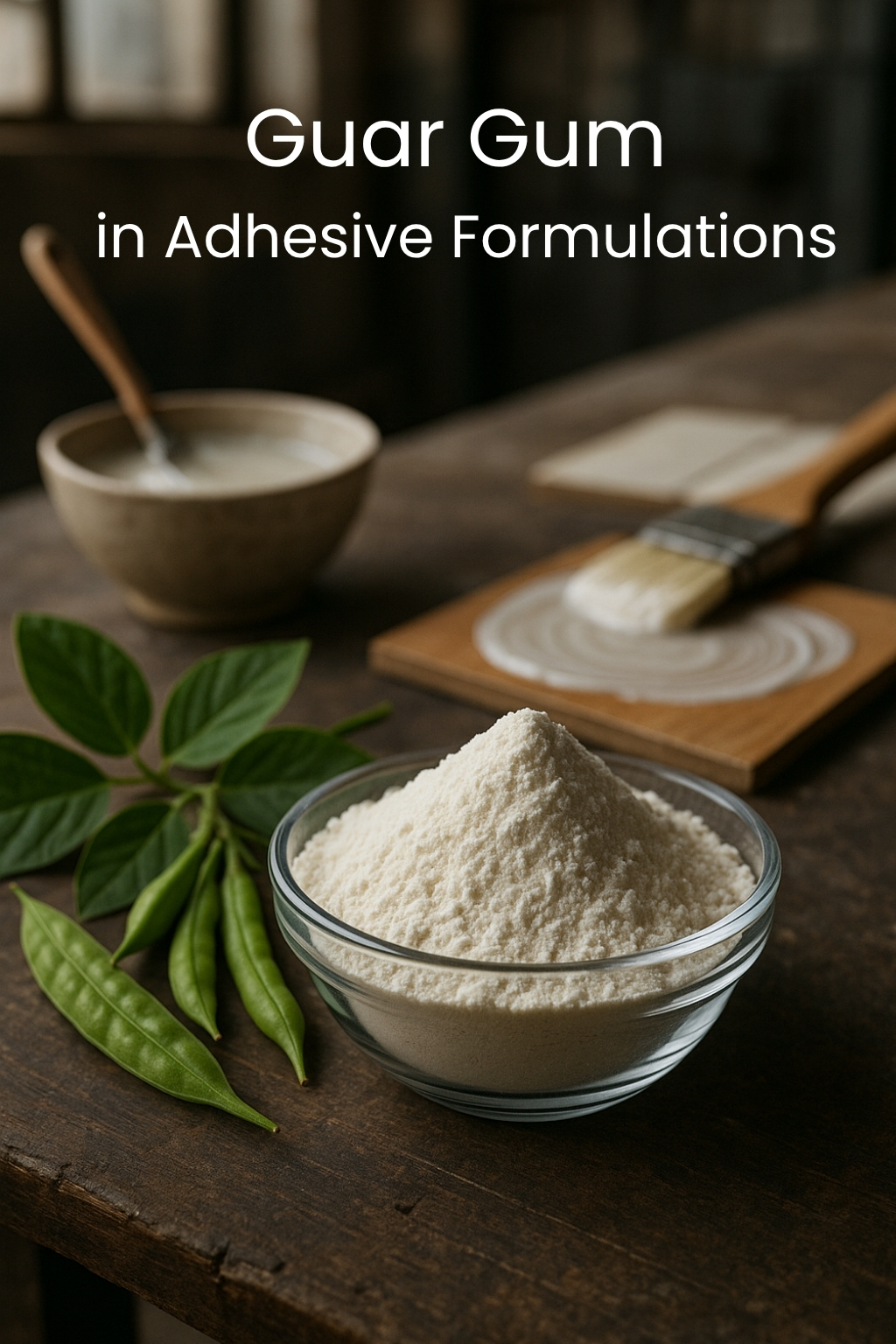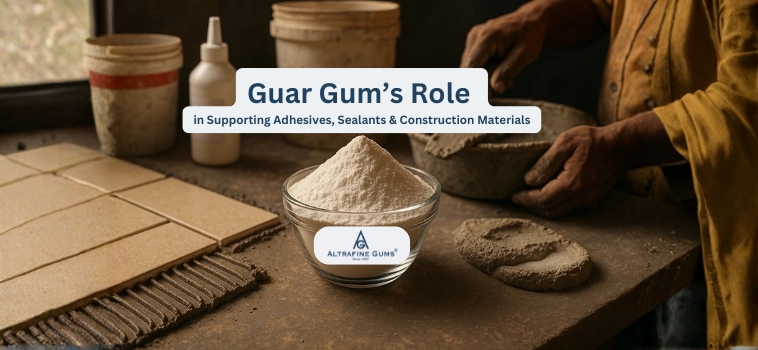Objective
The objective of this article is to explore the role of guar gum and its derivatives in supporting the development and performance of adhesives, sealants and construction materials. By examining its chemical properties, functional benefits and market demand, we aim to understand how guar gum powder contributes to sustainability and innovation within these industries.
Introduction
Guar gum, a natural polysaccharide derived from the seeds of the guar plant, has gained significant traction in the industrial sector due to its versatile properties. Commonly available in the form of guar powder, this eco-friendly polymer is utilized across various industries, including adhesives, sealants and construction materials. As demand for sustainable products grows, industries are increasingly turning to natural polymers like guar gum to replace synthetic chemicals. The shift towards more environmentally responsible solutions is evident in global market trends, where there is a growing emphasis on sustainability, biodegradability and lower environmental impact in both construction and manufacturing sectors.
This growing preference is motivated by several factors, such as regulatory pressures to minimize harmful chemicals and the rising consumer demand. Guar gum’s natural origin and biodegradable nature make it an attractive alternative, contributing to a significant change in how adhesives, sealants and construction materials are formulated.
Chemical and Functional Properties of Guar Gum
Guar gum’s molecular structure consists of galactose and mannose, two sugars that form a long-chain polysaccharide. This structure imparts distinct rheological properties to guar gum, making it an ideal candidate for use in products requiring thickening, gelling or binding. The viscosity of guar gum solutions is highly sensitive to factors like concentration and temperature, which enhances its performance in various applications.
In the adhesives and sealants sectors, guar gum powder serves as a highly effective thickener and stabilizer. It not only provides excellent water retention but also enhances the flow properties of adhesives, allowing for smoother application and improved consistency. As a natural binder, guar gum helps improve adhesion properties, providing greater bond strength compared to synthetic alternatives. Compared to materials like PVA (polyvinyl acetate) or starch derivatives, guar gum offers a natural, biodegradable option without compromising the functional performance required by industrial applications.
Guar Gum in Adhesive Formulations
In adhesive formulations, guar gum plays a multifaceted role. Its primary function is to act as a natural binder and a viscosity modifier, which is crucial for ensuring that the adhesive maintains its intended consistency during application. The use of guar gum in adhesives significantly enhances the adhesion properties, ensuring that the adhesive can bond effectively to a range of substrates, including paper, wood and various packaging materials. This is particularly useful in industries where packaging and labeling require efficient, long-lasting bonds.
Guar gum also supports film formation and stability. It enhances the ability of the adhesive to form a uniform, solid film once applied, preventing unwanted flow and sagging. As a result, it helps improve the overall effectiveness of adhesives, providing better holding power over time. Whether in water-based or solvent-based systems, guar gum is compatible with both, making it a versatile ingredient in adhesive formulations.
Types of adhesives using guar gum include those used in paper, wood and packaging, as well as specialized adhesives for labeling. Its natural properties make it an ideal choice for eco-conscious manufacturers looking to reduce their environmental footprint while still delivering high-quality products.

Application in Sealants and Joint Fillers
Guar gum’s unique rheological properties make it highly effective in sealant and joint filler formulations. As a rheology modifier, refined guar gum helps control the elasticity and flexibility of sealants, ensuring they can stretch and compress without losing performance. This is particularly important in applications like construction, where joints and gaps need to remain sealed despite expansion and contraction caused by environmental changes.
Guar gum also contributes to preventing shrinkage and cracking, a common issue in sealant products. It improves the workability and curing properties of the sealant, allowing for more efficient application without compromising the durability of the seal once set. For eco-friendly formulations, guar gum is an essential ingredient in developing biodegradable sealants, as it is derived from renewable plant sources.
In hybrid formulations, guar derivatives are combined with acrylic or silicone systems to create high-performance sealants. These combinations enhance the overall durability and adaptability of the sealant while maintaining the environmental benefits of guar gum.
Guar Gum in Construction Materials
In the construction industry, guar gum powder has found extensive use in materials like cement mortars, plasters and wall coatings. Guar gum serves multiple purposes in these products, including functioning as a water retention aid and thickener, which significantly enhances the workability of construction materials. By retaining moisture in cement or plaster, guar gum allows for better curing, reducing the chances of cracks and ensuring stronger, more durable finishes.
In concrete, guar gum contributes to slump retention, which ensures that the mix remains workable for longer periods, especially during extended transportation or placement times. This helps prevent the mixture from drying out prematurely, reducing the need for additional water and improving overall consistency. Additionally, Guar Gum can reduce the segregation of concrete, ensuring a more homogeneous mix and less risk of cracking, particularly in large-scale construction projects.
Gypsum-based products also benefit from the use of guar gum, as it improves their performance by preventing premature drying, reducing cracking and ensuring smooth application. These characteristics make guar gum an indispensable component of modern construction materials, where sustainability and ease of use are key considerations.
Market and Regional Demand
The adoption of guar gum in adhesives, sealants and construction materials varies by region. In Europe, countries like Germany, Italy and Poland have seen significant growth in the use of eco-adhesives, driven by stricter environmental regulations and consumer demand for greener products. This trend is supported by the growing focus on reducing the use of harmful chemicals in industrial applications, with guar gum offering a safer and more sustainable alternative.
In Asia, particularly in emerging markets like India, China and Malaysia, the demand for guar gum in construction materials is increasing due to rapid urbanization and infrastructure development. The region’s growing focus on green building materials and sustainability is helping propel the use of guar gum in various construction applications.
North America is also witnessing a shift toward biodegradable additives in the sealant industry. The move toward environmentally friendly sealants is gaining momentum, with guar gum playing a significant role in replacing petroleum-based ingredients. This trend aligns with the overall sustainability focus in the construction and manufacturing industries across the region.
Conclusion
As the global market for sustainable materials continues to expand, guar gum is poised to play an even larger role in the development of adhesives, sealants and construction materials. Its chemical and functional properties make it a versatile and effective solution for a wide range of industrial applications. Whether as a natural binder, viscosity modifier or water retention agent, guar gum powder is proving to be an essential component in creating high-performance, eco-friendly products. The increasing demand for natural and biodegradable alternatives to synthetic materials ensures that guar gum will continue to be a key player in driving sustainability within these sectors.
FAQs About Guar Gum Powder
What is guar gum?
Guar gum is a natural polysaccharide derived from the seeds of the guar plant, used as a thickener and binder in various industries.
How does guar gum benefit adhesives?
Guar gum enhances adhesion properties, consistency and film formation, improving the performance of adhesives for packaging and labeling.
Why is guar gum used in sealants?
Guar gum helps control elasticity, flexibility and prevents shrinkage, making sealants more durable and adaptable.
What role does guar gum play in construction materials?
In construction, guar gum aids in water retention, improving workability, curing and preventing cracking in materials like cement and plaster.
Where is guar gum most commonly used?
Guar gum is widely used in Europe, Asia and North America, particularly in eco-friendly adhesives, sealants and construction materials.

CEO, Altrafine Gums
With over Four decades of expertise in the natural gums and hydrocolloids industry, Ajit Patel leads Altrafine Gums, a globally recognized manufacturer and exporter of Guar Gum Powder, Cassia Tora Powder (Cassia Gum Powder) and other Hydrocolloids. Under his visionary leadership, the company has built a strong reputation for quality, innovation, and reliability across the food, feed, pet feed, pharmaceutical, mining, oil drilling and cosmetic sectors.
Altrafine Gums has been serving global industries for decades with a focus on sustainable sourcing, research-driven production, and stringent quality control. Its wide product portfolio includes Guar Gum Powder, Cassia Tora Powder (Cassia Gum Powder) and other plant-based hydrocolloids that serve as key functional ingredients in diverse applications.
Ajit Patel’s commitment to excellence ensures that every product from Altrafine meets international standards of performance and purity. He is passionate about advancing the global reach of Indian hydrocolloids, fostering customer trust, and promoting eco-friendly, science-backed solutions that enhance product formulation and performance worldwide.

